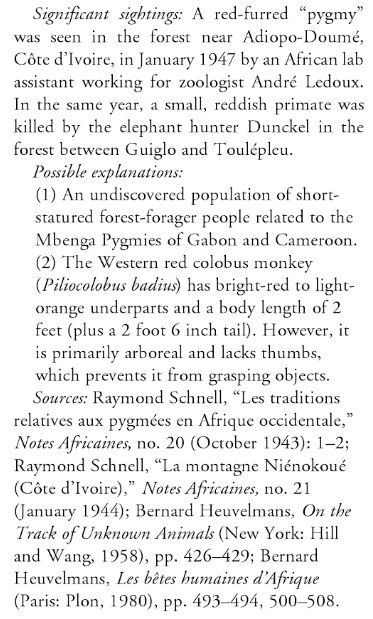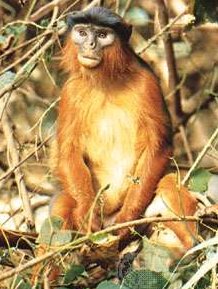Bernard Heuvelmans indicated in 1958 that Pr. André Ledoux, a zoologist in Ivory Coast, heard in 1947 that during one of his expeditions in the course of 1947, the great elephant-hunter Dunckel killed a peculiar primate unknown to him; it was small with reddish-brown hair and was shot in the great forest between Guiglo and Toulepeu, that is, between the Sassandra and Cavally rivers. Its remains disappeared while it was being carried home, no doubt having been disposed of by superstitious porters. Dunckel even offered to take Ledoux to the place.
This later appeared as a shorter summary in a ufology catalogue by British "skeptical" ufologist Peter Rogerson.
|
|
[Ref. ge1:] GEORGE M. EBERHART:

|
|
Significant sightings: A red-furred "pygmy" was seen in the forest near Adiopo-Doume, Cote d'Ivoire, in January 1947 by an African lab assistant working for zoologist Andre Ledoux. In the same year, a small, reddish primate was killed by rhe elephant hunter Dunckel in the forest between Guiglo and Toulepleu. Possible explanations: (1) An undiscovered population of short-statured forest-forager people related to the Mbenga Pygmies of Gabon and Cameroon. (2) The Western red colobus monkey (Piliocolobus badius) has bright-red to light-orange underparts and a body length of 2 feet (plus a 2 foot 6 inch tail). However, it is primarily arboreal and lacks thumbs, which prevents it from grasping objects. Sources: Raymond Schnell, "Les traditions relatives aux pygmees en Afrique occidentale," Notes Africaines, 110. 20 (October 1943): 1-2; Raymond Schnell, "La Montagne Nienokoue (Cote d'Ivoire)," Notes Africaines, no. 21 (January 1944); Bernard Heuvelmans, On the Track of Unknown Animals (New York: Hill and Wang, 1958), pp. 426-429; Bernard Heuvelmans, Les betes humaines d'Afrique (Paris: Plon, 1980), pp. 493-494, 500-508. |
[Ref. is1:] IVAN T. SANDERSON:

|
|
[...] During one of his expeditions in the course of 1947 the great elephant-hunter Dunckel killed a peculiar primate unknown to him; it was small with reddish-brown hair and was shot in the great forest between Guiglo and Toulepeu, that is, between the Sassandra and Cavally rivers. Its remains disappeared while it was being carried home, no doubt having been disposed of by superstitious porters. Dunckel even offered to take my informant [Professor A. Ledoux] to the place and he in turn invited me to go with them. [...] |
Note: Ivan T. Sanderson indicates that this is reproduced from Heuvelmans [bh1]. The story is thus told by Heuvelmans, not Sanderson.
[Ref. pr1:] PETER ROGERSON:
|
1947. GUIGLO (MOYEN CAVALLY : IVORY COAST) An elephant hunter Mr Dunckel killed a small primate with red brown hair in the forest between here and Toulepleu. The corpse disappeared on the journey home. Heuvelmans 1962 p 428 |
Bernard Heuvelmans (1916 - 2001), cited in [pr1] as the source, was a Belgian-French scientist, explorer, and author. He was the founder of what became known as cryptozoology, the search for previously unknown animals. His work of course had nothing to do with UFOs or aliens.
Bibliographies of Heuvelmans do not list a book for 1962. The [pr1] reference to "Heuvelmans 1962 p428" is likely rather some reissue of "On the Track of Unknown Animals", by Heuvelmans, published in 1958 and 1959.
"Skeptical" British Peter Rogerson [pr1] explained why he included such stories in his INTCAT catalogue: it was to show that inventions and imagination always existed, resulting in fairy, ghost, weird animal reports, all mistakes or hoaxes, so that UFO occupants sighting reports must be of the same kind.
Hunter Dunckel killed the "creature", and meant to bring it with him. It goes without saying that he saw it closely, and that if it had been anything else than a monkey, he would have mentioned it and could have seen and described what made it something else than a monkey.
Colobus monkeys are found in two genera, Procolobus and Piliocolobus. Most are black and white, but some show red, such as Piliocolobus Badius Temminckii:

|
Ref.: www.britannica.com/animal/colobus
The difficulty is that Colobus Badius Temminckii is an endemic species of East Africa, not expected to be found in Western Africa. But can we totally exclude that it also lives in Ivory Coast? And can we exclude that one or the other escaped there from a transport ship for example?
The "skeptical" point of view - invention or misinterpretation - does not hold at all here. There is no reason to think of a misinterpretation, we are told of a monkey, and so would it be instead of a monkey, when the witness killed it, got hold of the corpse and was in a position to look at it in detail?
It should therefore be an "invention". But what would be the meaning of such an invention, since there is nothing spectacular, or "irrational"? What arguments do we have to show that this episode is a "hoax"?
| Id: | Topic: | Severity: | Date noted: | Raised by: | Noted by: | Description: | Proposal: | Status: |
|---|---|---|---|---|---|---|---|---|
| - | ||||||||
Probable monkey, not UFO-related.
* = Source I checked.
? = Source I am told about but could not check yet. Help appreciated.
| Main Author: | Patrick Gross |
|---|---|
| Contributors: | None |
| Reviewers: | None |
| Editor: | Patrick Gross |
| Version: | Created/Changed By: | Date: | Change Description: |
|---|---|---|---|
| 0.1 | Patrick Gross | October 12, 2018 | Creation, [ge1], [is1], [pr1]. |
| 1.0 | Patrick Gross | October 12, 2018 | First published. |